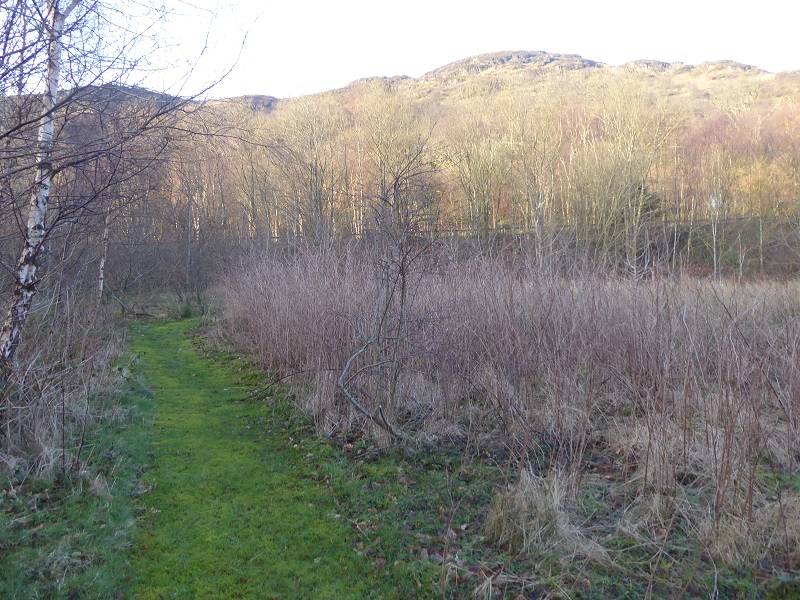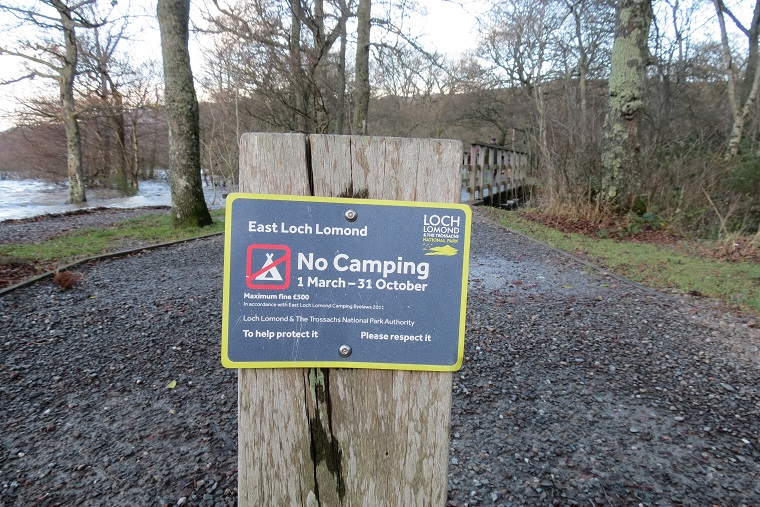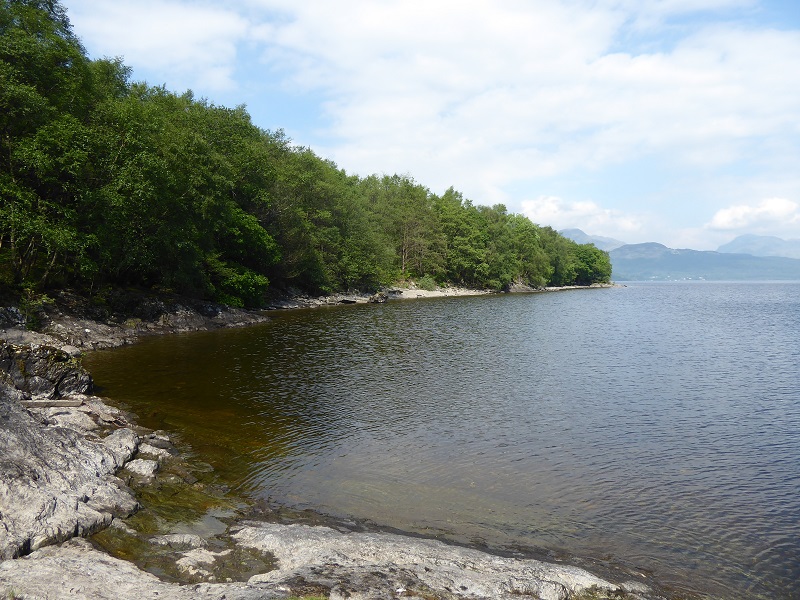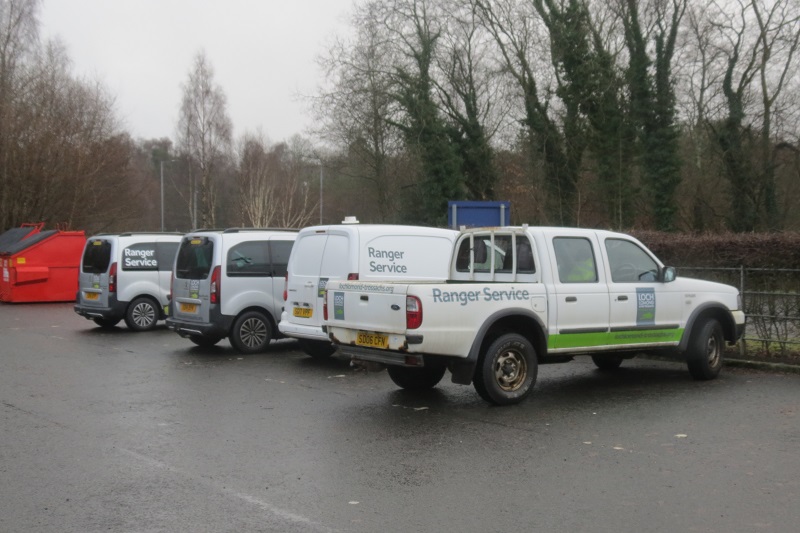
If you have not heard it, most of Saturday’s episode of BBC Radio Scotland’s Out of Doors programme (see here) was devoted to Scotland’s access legislation as it approaches its fifteenth anniversary. If you want to understand the amazing story of how our access rights were secured – and in this case “our” really does mean our, as anyone who ever steps foot in Scotland has those rights and they apply to everyone, from the homeless to the Queen – or the background to continued access problems and challenges, including those in our National Parks ((see here) or (here)) I commend the whole programme. (And for those who don’t have the time to spend 1.5 hours listening I give the approx times of the various interviews and their content at the end of this post).
While most of the programme was a celebration of the successes of our access legislation, the programme gave significant coverage to the camping byelaws. I was pleased to participate, balanced by a contribution from Loch Lomond and Trossachs National Park Authority staff and excellent commentary/questioning from the presenters Mark Stephens and Euan McIlwraith. The interviews with staff were very revealing. This post will take a critical look at what was said within the context that most of the people involved in securing our access rights, including many interviewed on the programme, believe the camping byelaws and the Loch Lomond and Trossachs National Park Authority pose the biggest single threat to those rights.
The operation of the warning system
In their Review for Ministers of how the byelaws had operated in their first year, the LLTNPA reported that it had issued 828 warnings to campers. It is not clear on what legal authority (see here) the LLTNPA has instigated this warning system – I have now asked them to clarify this – but what the programme revealed is that the Park is keeping data on people it has warned for three whole years.

The programme revealed what the LLTNPA has to date refused to reveal under Freedom of Information, how its enforcing the camping byelaws. Simon Jones explained it as follows, stating that “we will do everything in our power to let you stay” so long that is that either you move into a permit area and buy a permit or move out of the camping management zone – in other words there is NO power to let people camping responsibly stay! While Simon Jones said the byelaws, the criminal offence, are only being applied to people who are “intractable” and won’t follow the directions of rangers, the Ranger clarified that they are taking the name and address of people found in breach of the byelaws. Whether all of these people are then being issued official warnings is still not clear.
The LLTNPA has always said it does not want to criminalise campers, not I believe because it respects responsible campers – one thing that came across to me in the programme is that Park staff see any camper as a problem needing “management” and “education” – but because this would be a public relations disaster. So, what they have decided to do is to create a warning system and hope that the threat of having the camper’s name and address and the potential of a future referral to the Procurator Fiscal will be sufficient to deter a person from ever again camping without a permit.
Its within this context that the LLTNPA are saying to the Minister in their Review Report that its too early to tell if the camping byelaws have worked. The byelaws clearly aren’t working at present as intended as lots and lots of people are still camping where camping has been banned. The LLTNPA is hoping however that as they add more and more names to their files fewer and fewer people will camp. It would be interesting to know if any other criminal law in Scotland has ever been implemented in this way.
Its ironic that at the same time the Scottish Parliament has been cleaning up the behaviour of Police Scotland, which has reduced the number of stop and searches from over half a million to 20,000 or so, its allowed the LLTNPA to instigate a STOP AND PERMIT system for campers. If you doubt that this what it is all about, listen to the Ranger who describes herself as “an enforcement officer”. Time that the Scottish Parliament, in celebrating our access legislation, started to scrutinise what is going on in the LLTNPA.
The position of caravans and campervans
Legally, the byelaws allow people to stay overnight in a vehicle on a “road”, which is defined to include both public roads and private roads over which there is a right of passage, in any camping management zone. When asked about this Simon Jones, Director of Conservation, replied:
“if you are in a car you have the opportunity to stay in a layby and rest where you want to on the public road [note he avoided mentioning people sleeping ovenight], off the public road is another matter………..”.
This was a false statement and was picked up by Mark Stephen:
“with respect that is not what it says in the byelaws, the word public road is not in the byelaws………….”.
Simon Jones then acknowledged this but avoided clarifying the Park’s stance:
“ok, the interpretation I think (pause) the important thing to remember is what we would do as an authority to try and help you [why would someone doing nothing wrong need help?], educate you………...and as a last resort enforce something we don’t want to have to do”
Oh dear! So what is the Park’s approach to campervans and caravans? We don’t know, apart from that the LLTNPA claim they are now following the advice of Police Scotland, whatever that is (they refuse to release it). The problem for the LLTNPA, epitomised by Mr Jones convoluted response, is that if they publlcly accept the byelaws effectively no longer apply to campervans and caravans, half the justification for the byelaws collapses (the main reason local community councils supported the byelaws proposals was they were told this would address the problems of caravans parked up for the summer in laybys). Then the manifest unfairness of applying the byelaws to campers and not to people in vehicles (nicely brought out by Mark Stephen in his question about why a cyclist should not be able to stop off for a rest like a car driver or campervan owner) becomes ever more apparent.
The LLTNPA need to make public the instructions they have issued to staff about how the byelaws apply to campervans and caravans, including the legality of their attempts to charge people for stopping on places that are part of the road network (e.g Inveruglas). Because I doubt they will do this, I have submitted an FOI request asking the LLTNPA how many warnings have been issued to people stopping overnight in campervans and caravans. When that eventually becomes public, as I am confident it will, it should help show if LLTNPA are abusing their powers or have effectively abandoned trying to enforce them against campervans.
Parkspeak
The LLTNPA provided a number of choice examples of parkspeak in their interviews (I don’t blame the Ranger for this, she was only doing what she was told). These are important because these are about trying to change the way both staff and the public think about access rights.

The LLTNPA interview took place at Milarrochy bay. Instead of openly acknowledging they want to ban campers from places such as this, the byelaws are now being presented as being part of a “toolkit”. (This is a significant change since the Your Park consultation never asked people what they thought about toolkits and what should be in them). What Mark Stephen’s exposed in his “role play” with the Ranger is just what a useless tool the byelaws are. If you refuse to give your name and address and follow the directions of Park staff, whether you are camping according to the Scottish Outdoor Access Code or chopping down trees, LLTNPA staff still have to call the police – the same remedy that has always been available to address situations where people have been breaking the law.
Both Simon Jones and the Ranger also claimed that the byelaws are about protecting the National Park for “future generations to enjoy” . This is complete and utter rubbish and very dangerous. Rubbish because vegetation impacted on by people camping normally recovers within a season, and where it doesn’t does not need byelaws to make it happen. Dangerous because if you accept the logic for campers, day visitors will be next (they also have impacts on vegetation, leave litter and sometimes chop down trees – which always was a criminal offence anyway). The impacts of visitors are simply not comparable to issues like climate change, where pumping ever more carbon into the atmosphere does risk the ability of future generations, or land management in the National Park. It will be interesting to see if the LLTNPA apply the future generations argument to the forthcoming Cononish gold mine planning application (which is in a wild land area) or whether this parkspeak about “future generations” is only applicable to the impacts of campers.
Simon Jones also repeated the claim, which now appears the LLTNPA’s main justification for the byelaws, that they are needed because of the “sheer volume of campers”. This is again nonsense and the LLTNPA is deliberately trying to hide the truth of what is going on. Before meeting Mark Stephen and Euan McIlwraith I prepared an illustration of this from the data I have for Firkin Point (where I was interviewed) and west Loch Lomond.
| Firkin permit area | No Places | Bookings | Numbers feedback | Percent positive |
| Motorhomes | 6? | 159 | 33 | 91% |
| Tents | ||||
| Zone A (larger grass area) | 3 | 51 | 4 | 75% |
| Zone B (small grass area) | 2 | 30 | 1 | 100% |
| Zone C (beach) | 1 | 27 | 4 | 75% |
| Zone D (south road) | 9 | 24 | 2 | 0 |
| 132 | 11 |
Booking and feedback 1st March- 26th June 2017 from info released under Environmental Information Regulations in August (EIR 2017-055) (I am still waiting for useable data on bookings post 26th June).
Compare this data with Ranger Patrol records for Firkin for 2013 and 2014:
April – June 2013 Numbers of tents – 8 (Source Ranger patrol records supplied under FOI)
April – June 2014 Number of tents – 0 (Source Range patrol records supplied under FOI)

Now, not every booking under the permit system will have resulted in someone camping and, while Ranger patrols took place most days, they rarely visited the south road (location of zone D). Setting aside these qualifications, there has been a huge increase in the number of people camping at Firkin Point (from 8 tents up to 132). How does this fit with the LLTNPA’s claim the camping byelaws are about managing the volume of campers or it is just another lie?
I think two things are happening here. The first is some people who never knew about Firkin Point are being attracted to stop off there, probably on their way to somewhere else, because it is now being advertised as somewhere to camp. The availability of toilets (but not chemical disposal points) – even though these are closed when the byelaw season starts – adds to the attraction. The second is that people who previously would have been spread out along the loch shores are being forced to camp in places like this. As evidence of this, consider my analysis of camping on west Loch Lomond prior to the implementation of the byelaws West Loch Lomond Ranger Data analysis which shows that in the whole of 2013 Rangers recorded 130 tents along the whole of the west shore of Loch Lomond. Yes, the total number of people issued permits to camp at Firkin Point in four months, exceeded the number of campers found on the west shore in a whole season. Incredible! The LLTNPA’s claim that the byelaws are about controlling the number of campers is therefore a lie, a lie which their staff need to stop repeating. The byelaws are about controlling people, forcing people to camp where petty park bureaucrats and certain landowners are prepared to let people camp, rather than letting people to choose where it makes sense for them to camp..
Cost benefit analysis

At the end of the interview, Mark Stephen reported he had asked LLTNPA staff about the closed toilets at Firkin Point and they had said this was due to lack of resources. This is the first time LLTNPA staff have, to my knowledge, publicly acknowledged that their toilets should be open more – a step forward. To attribute this to lack of resources, however, is garbage. Here’s why.
The LLTNPA has far more to spend on visitor management to the countryside than any other public authority in Scotland. The problem is that it has decided to devote almost all its resources to policing camping rather than using its resources to the benefit of ALL visitors. As an illustration of this, I arrived at Firkin Point on Thurday to find a LLTNPA ranger van sitting there but the toilets locked. If the LLTNPA can afford to pay Rangers to visit sites where toilets are located in the middle of winter, it could afford to can afford to keep them open, send someone in to check them occasionally and clean them if necessary. I am not saying that it should necessarily be Rangers who should do this, but if the LLTNPA redeployed a small part of the resources used to employ seasonal rangers to cleaning toilets and emptying bins, they could keep toilets open year round and prevent much of the litter problem in the National Park happening in the first place.
What’s more, while I support the need for new campsites in the National Park, when their campsite at Loch Chon has only 20% occupancy (as predicted), its clear that the £345k and more of capital monies so far spent on developing that campsite would have been far better spent on installing new toilets and chemical disposal points throughout the National Park. That would have benefitted not only campers, and far more of them, but the general public.
The LLTNPA never undertook a cost benefit analysis while developing its byelaw proposals and its review report to Ministers says nothing about the amount of scarce public funds which have been wasted to date. Unless the LLTNPA starts acting more rationally and responsibly on this, the Minister Roseanna Cunningham should transfer both its capital and revenue resources to help those public authorities who do want to improve tourist infrastructure but really don’t have the resources to do so. Skye and the North Coast 500 provide good examples and alternatives.
Where next?
I am happy to predict that on this showing, and as more information becomes available, during 2018 the camping byelaws along with the LLTNPA’s reputation as a National Park will continue to collapse. The main question now is whether it will be the Scottish Government or the new Board which will see sense first. This will mean re-affirming that camping by the loch shores can and should be managed within the framework set out under access rights and while resources need to be directed to where they will have most effect.
Interviews in programme (approx times into programme in brackets)
- Roseanna Cunningham, Environment Minister “this is a right they cannot get around” (3.25)
- Dave Morris on history leading up to final legislation and what issues are now(6.30)
- Alison Riddell Scotways on continuing access issues (12.45)
- Andrew Bachell (now Chief Exec JMT) on SNH role drafting legislation (23.45)
- Discussion between reporters Euan McIlwriath and Mark Stephens on one of the Loch Lomond and Trossachs National Park’s camping permit areas at Firkin Point: “you would not camp there if you had the choice”
- Cameron McNeish on politics around the legislation and since (37.01)
- Jess Dolan Director Ramblers Scotland on making more people aware access rights (44.45)
- Lauren MacCallum on Patagonia film on snow boarding and access (46.30)
- Nick Kempe at Firkin Point (52.00)
- Simon Jones, Director Conservation and Lea Hamilton, Ranger at Milarrochy Bay (1.02).
- Dennis Canavan (1.13.30) on his amendment to include Balmoral in legislation
- Bob Reid (past convener National Access Forum) on the legislation, planning and paths (1.20)
- Andy Wightman on agenda outdoor recreation (1.24.30)
